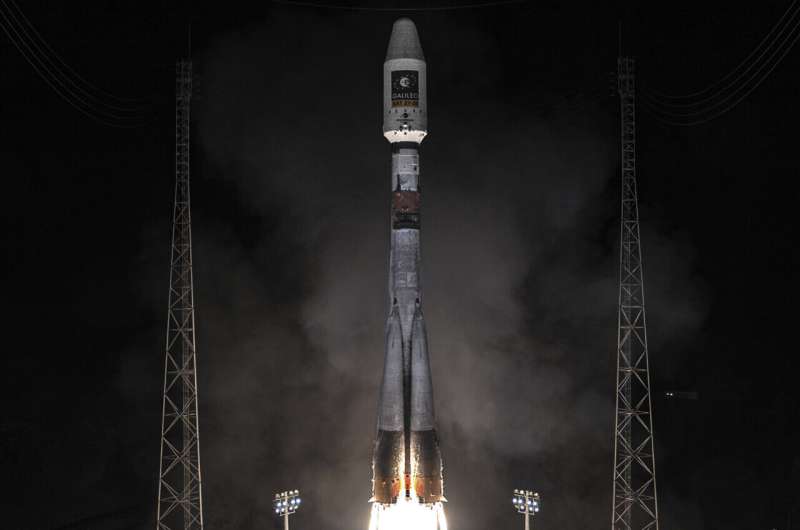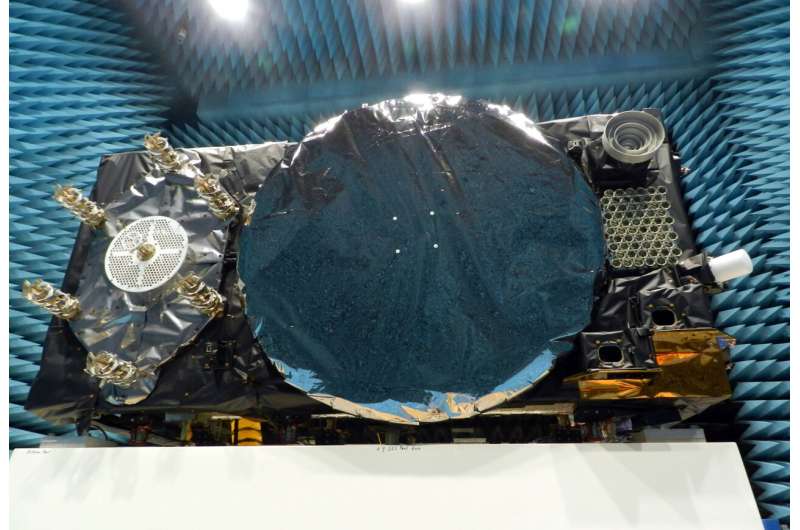Launch of Soyuz VS26 from Europe's Spaceport in French Guiana on 5 December 2021 carrying European global navigation system satellites Galileo 27 and 28. Credit: ESA/CNES/Arianespace
Europe's latest Galileo satellites in space have joined the operational constellation, transmitting navigation signals to three billion users across planet Earth as well as relaying distress calls to rescuers. Their entry into service follows a summer test campaign and will result in a measurable increase in positioning accuracy and improved data delivery performance of the overall Galileo system.
Galileo satellites 27–28 were launched at the end of last year and underwent their in-orbit test review at the end of April, held between ESA, satellite manufacturer OHB and navigation payload maker Surrey Satellite Technology Ltd (SSTL). Their key findings included the fact that both satellites' payloads are performing extremely well—among the best in the entire constellation—and that both satellites entering into service increase the position accuracy and robustness of the overall Galileo system.
A successful system/operations in-orbit test review followed, co-chaired by ESA and EUSPA, the EU Agency for the Space Program, in overall charge of commissioning, which confirmed the satellites' health.
Now, following a successful test campaign this summer, these two new Galileo satellites have become the first to broadcast an improved navigation message, resulting in three key improvements for Galileo's public Open Service users.
- Faster navigation data acquisition allowing users to establish a first position fix more rapidly.
- Better robustness in challenging environments, such as urban centers where the visibility of satellites can be reduced by high buildings.
- Easier access to timing information in the navigation message for users possessing only a rough estimate of timing of the order of 1–2 seconds.
Seen here sheathed in multi-layer insulation, the 2.5m by 1.2 m by 1.1 m satellite’s main 1.4-m diameter antenna transmits L-band navigation signals down to Earth. To its left is the hexagonal search and rescue antenna that picks up distress signals and relays them to local emergency services, contributing to the saving of more than 2000 lives annually. Credit: European Space Agency
For the testing and broadcasting of this new navigation message, new software for the Navigation Signal Generation Unit was developed by Thales Alenia Space in Italy, SSTL, OHB and ESA and was uploaded to the two satellites.
During the summer, an extensive test campaign was conducted by ESA to ensure the compatibility of the entire Galileo system at unit, payload, satellite, ground, and system levels with the enhanced message. As part of this effort EUSPA oversaw receiver testing, to ensure this compatibility extended to the Galileo receivers and chipsets in the market. These latest launched satellites made ideal test cases for the software and the improved navigation message.
Stefan Wallner, Head of the G1 Signal in Space Engineering Unit, comments: "This testing was crucial for the entire Galileo system, as it means that end-users are now able to receive a first positioning fix twice as fast, down to just 16 seconds."
Transmission of the upgraded signals from Galileo satellites 27–28 allowed the team to confirm its correct implementation and characterize its long-term performance. Following a successful Test Review Board, the satellites were brought back into service on 29 August.
Bastiaan Willemse, heading ESA's Galileo Full Operational Capability Satellite Management Service notes: "Now that the testing is complete, we reach an exciting moment for the entire Galileo family, because this is the point at which users can begin to take benefit from these new Galileo satellites. In addition, the upgrades will further boost the performance of the overall Galileo system. This new software will be not only uploaded to every Galileo satellite already in orbit from this October onward, but all the satellites that are still to be launched will have it integrated as well."
Provided by European Space Agency

























